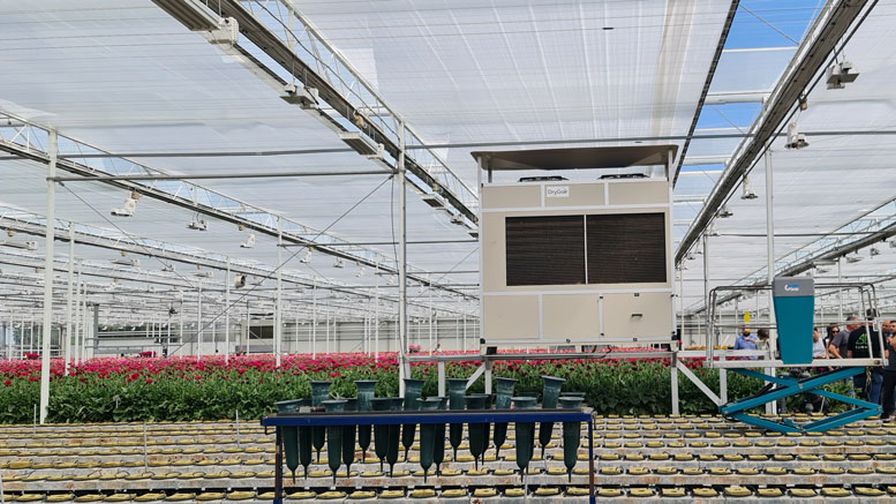
Summit Gerbera Growers production equipment | DryGair
Greenhouse flower production has been undergoing a significant shift over the past few years. Around the world, more and more growers are switching to fully LED-lit facilities. This is coupled with improved insulation, such as energy screens, and active dehumidification, to control the inevitable humidity buildup.
One crop that has seen an especially fast development on this front is gerbera daisies, with Dutch growers, in particular, being ahead of the curve. Many large-scale producers are already operating fully LED-lit greenhouses, utilizing multiple screens, and integrating active dehumidification systems, such as DryGair.
Why Are Gerbera Growers Updating Their Production Techniques?
Perhaps the biggest reason for this new movement has to do with energy consumption. High energy prices and tightening carbon emission regulations make it necessary to improve energy efficiency. Rising energy costs have hit the greenhouse flower sector especially hard, as many growers already know.
Flowers, such as gerbera daisies, require a high level of environmental control. They’re highly sensitive to changes in growing conditions and need specific climate conditions to maximize growth potential and quality, which drastically affects their market value.
Joyce Lansbergen, the owner of LG Flowers, mentions in an interview with Onder Glas, “Like many others, we have accelerated the switch to LED lighting. 80% of our company was immediately covered with LED, which was accompanied by many ‘learning moments’. So, before this winter started, we implemented changes so that growing under LED would work out better. We invested in screens and DryGair (active dehumidifiers). Our greenhouses were drier than ever last winter.”
The Benefits of Growing Using Climate Screens, Dehumidifiers, and LEDs
There are several benefits to switching to this new way of growing. First, is the ability to save energy.
Wilco Westerman, of Oudijk Gerbera, discusses energy savings in an interview about this transition with Royal Brinkman, “The screen stays closed, the vents stay closed, the heating does not need to be turned on unnecessarily and we do not lose heat/energy. We have been able to save 40% on gas consumption.”
Significant Energy Savings
LED lights are significantly more efficient, and consume less energy than traditional HPS lamps, such as SON-T. This allows growers to turn their lights on for longer periods of time. Even all day, when beneficial. This, in turn, lets growers rely less on sunlight, allowing them to utilize more thermal screens without losing radiation.
However, while transitioning to LED and installing energy screens can drastically reduce energy costs, it also creates a serious challenge – high humidity. This, of course, can be solved by incorporating active dehumidifiers to reduce humidity.
Yield Improvements Associated with Humidity Control
High humidity poses a serious threat to flowers, including gerbera daisies. It’s the leading culprit for some of the most common diseases, such as botrytis. Reducing humidity, and maintaining a level of 60-70% RH, prevents outbreaks at a very high rate.
Additionally, high humidity simply isn’t conducive to growing high-quality flowers. This is true for most crops. When humidity is too high, plants struggle to transpire, meaning they aren’t able to release moisture. Transpiration is the force that causes the plant to take in more water, which is its source of nutrients.
In short, high humidity slows down or even stops the plants’ physiological processes, including growth and flowering. So overall, maintaining proper humidity levels increases yields and improves quality.
Westerman of Oudijk Gerbera mentions, “The main reason for investing in dehumidifiers was to improve the quality of our gerberas, as well as energy savings. We are known for our good quality, and we want to keep it that way. We now prevent high humidity in the greenhouse, and botrytis is no longer a problem.”
Better Yields at Lower Costs
New innovations, such as efficient lighting and powerful dehumidification allow gerbera growers to both maximize production potential and cut costs.
While this method is still relatively new, it’s already being adopted by hundreds of growers around the globe. There’s no doubt that, as energy prices continue to rise, and regulations continue to be enacted, these techniques will become common practice in more and more markets.
As Lansbergen of LG Flowers says, “Despite a 25% saving on gas, our crop has never looked so good, and production was higher than expected.”

